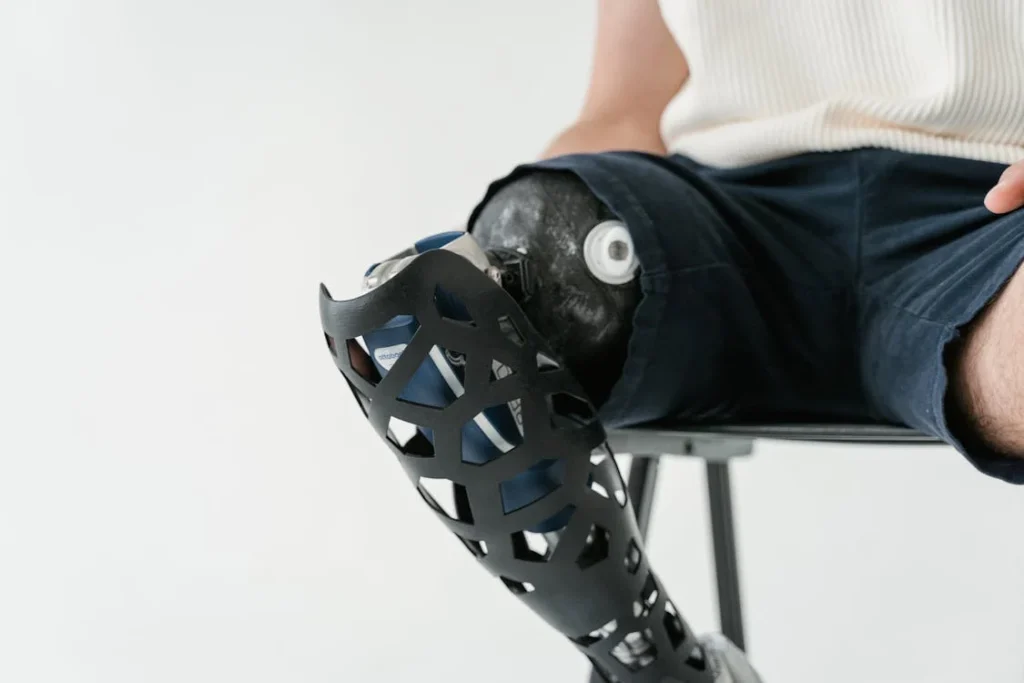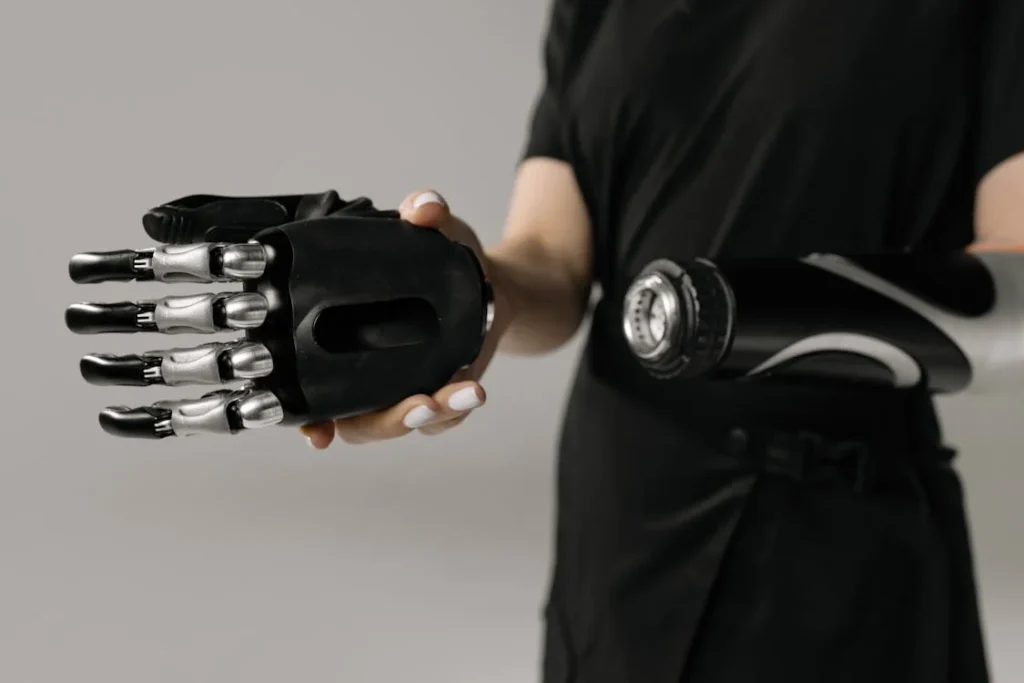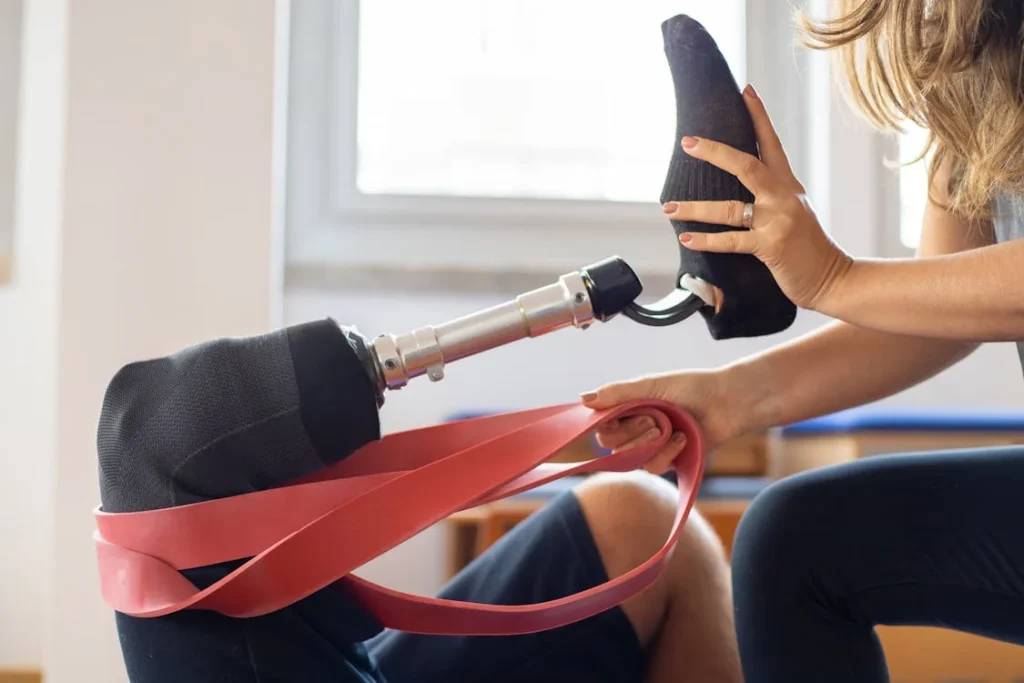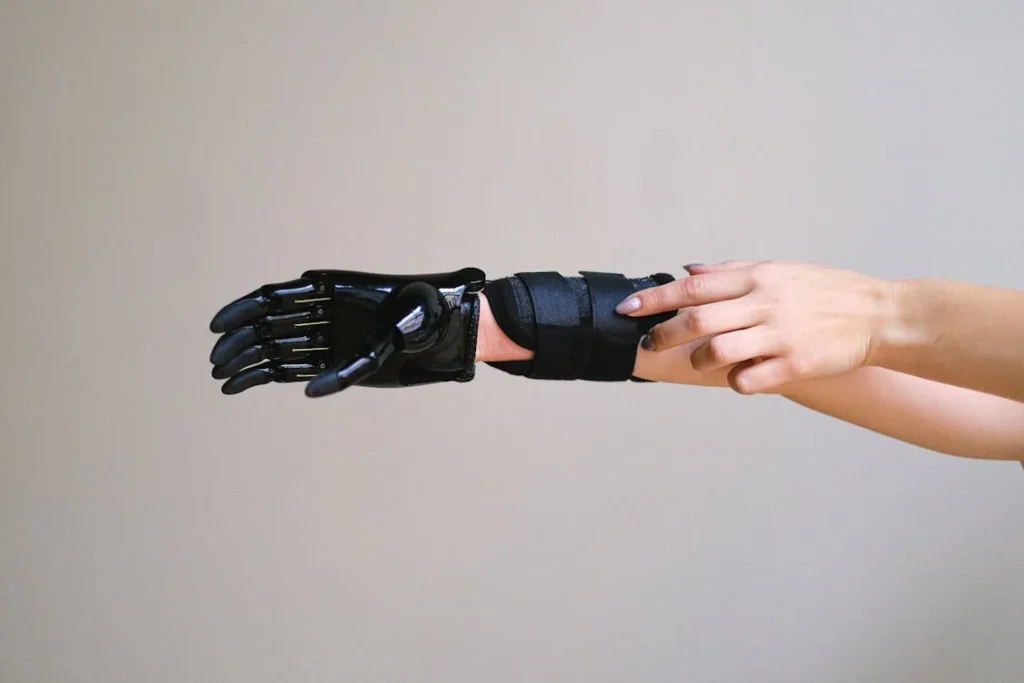When a child starts using a prosthetic, it marks the beginning of a journey—one that involves not just learning to use the limb, but caring for it over time. As children grow and change, so must their prosthetic. What fits well and feels right today might not be enough six months from now.
Prosthetics are not one-time solutions. They need regular care, timely upgrades, and close attention to small changes. Without proper maintenance, even the best prosthetic can become uncomfortable or limit movement. For children, this can affect not only physical activity but also confidence and emotional well-being.

Daily Use and Early Signs of Wear
The first step in maintaining a prosthetic is simply paying attention. Pediatric prosthetics go through a lot. Children are active, curious, and constantly moving—from climbing on furniture to crawling under tables, riding bikes, and playing on the ground.
While prosthetics are built to be tough, they still need daily care to stay in good condition.
Start by observing how your child uses the limb each day. Watch for any changes in how they walk, run, or use their hands. If they suddenly start avoiding certain movements or complain that something feels “off,” it’s a sign worth checking.
Children often won’t say something is wrong directly, but their actions will show you if the fit is no longer right.
Some physical signs are easier to spot. Red marks on the skin that last longer than a few minutes, swelling near the socket, or areas that seem unusually tight or loose all suggest the prosthetic needs adjustment.
These may not be major problems yet, but if left alone, they can lead to pain or even injury.
The goal of early maintenance is to catch these small shifts before they become big issues.
A minor strap repair or soft padding adjustment, done early, can prevent discomfort and reduce the chances of a child avoiding the prosthetic altogether.
Creating a Simple Daily Care Routine
One of the easiest ways to extend the life of a prosthetic is by keeping it clean and dry. Sweat, dust, and dirt build up quickly, especially with daily use. Over time, this can cause skin irritation or damage to parts of the limb.
A gentle wipe-down with a soft cloth at the end of each day is usually enough. Focus on areas that come into direct contact with the skin.
Make sure straps, joints, and padding are free of moisture. Avoid harsh cleaners or scrubbing tools, as they can wear out materials faster.
Let your child take part in this process if they’re old enough. Turning maintenance into a short routine—just a few minutes before bedtime—can help them feel more responsible and confident about their prosthetic.
It’s also a good chance to check in and ask how it’s feeling without making it seem like an exam.
Over time, children who help with daily care tend to become more aware of their own comfort and more likely to speak up when something feels wrong.
Understanding Normal Wear vs. Damage
Not every scratch or squeak is a problem. Some wear is normal, especially in active children. Cosmetic scuff marks, small chips on outer covers, or slight fading from sun exposure won’t affect function.
However, issues like clicking joints, loose parts, or changes in alignment need attention.
Knowing the difference helps parents avoid unnecessary worry while still being proactive. If something seems unusual but doesn’t cause pain or limit function, just note it and keep an eye on it.
If the child’s movement changes, or they start adjusting how they use the limb to avoid discomfort, it’s time to schedule a review.

Planning for Growth: When and How to Adjust
Children grow fast—and sometimes, unpredictably. A prosthetic that fits perfectly one month may feel tight or awkward just a few months later.
This constant change is natural, but it means prosthetics must keep up. Without timely adjustments, a child might start using the prosthetic less, develop poor posture, or experience pain that interferes with play and learning.
The key is to stay ahead of growth, not just react to it. This means checking in regularly—not only when something feels wrong.
For younger children, a review every three to six months is usually a good rhythm. Older kids and teens may need different schedules depending on how fast they’re growing and how active they are.
Noticing the Small Shifts
Growth doesn’t always show up in obvious ways. It can start as a slight misalignment, or as a feeling that something is “off” even though the limb looks fine.
Maybe the prosthetic starts to shift during movement or doesn’t sit evenly when walking or standing. These small signals matter. They often show up before any pain begins.
Sometimes the changes are less about size and more about shape. As muscles strengthen and bones grow, the residual limb may take on a different form.
This can make the socket feel too tight in some spots and loose in others. The limb might also sweat more or develop skin irritation from uneven pressure.
Rather than waiting for these issues to worsen, it helps to keep track of changes in comfort and function over time. A simple notebook, or even short notes on your phone, can be a helpful tool during follow-up appointments.
Writing down when the child says something feels strange, or when you notice unusual wear, gives the prosthetist better insight into what needs adjustment.
Types of Adjustments
There are different ways to adapt a prosthetic as your child grows. Some adjustments are quick, like changing padding or refitting straps.
These can often be done during a single appointment. Others, like resizing the socket or changing the alignment, take more time and planning.
When growth is more significant, a full socket replacement may be needed. This sounds like a big step, but it’s often part of normal care.
Replacing the socket doesn’t mean starting over—it just means updating the fit so your child can stay active and pain-free.
If your child uses a myoelectric prosthetic, adjustments also include sensor placement. As muscles shift and develop, sensors may need to be repositioned to continue working correctly.
Making these changes at the right time keeps the prosthetic responsive and easier to use.
Planning Ahead for Transitions
Some changes are predictable—like the start of a growth spurt or the transition from early childhood to school age. Planning ahead for these phases can make upgrades feel smoother.
Talk with your prosthetist about what to expect in the months ahead. Ask if a temporary adjustment will be enough, or if it makes sense to start preparing a new socket.
Keeping an open line of communication with your care team, combined with regular observations at home, helps ensure your child never has to reach the point of discomfort before action is taken.

Upgrading Prosthetics: More Than Just a Better Fit
Upgrades are not just about replacing what no longer works—they’re about moving forward. As children grow, their physical abilities expand. So do their interests.
A prosthetic that once supported basic movement may eventually need to support sports, music, or even fine motor tasks like writing or drawing.
Recognizing when it’s time for an upgrade—and knowing how to approach it—can make a big difference in your child’s comfort and confidence.
When Is the Right Time to Upgrade?
Upgrades don’t always happen on a set timeline. Some are triggered by a change in the child’s needs.
For example, a child who once just needed a prosthetic to help with balance may now want to use both hands during art class or play a musical instrument.
These moments are opportunities to introduce new features or switch to a design that supports more function.
Other upgrades are needed when the prosthetic starts holding the child back. Maybe they’re avoiding activities they once enjoyed or struggling to keep up with peers in physical play.
These aren’t just signs of wear—they’re signs that the prosthetic needs to grow with the child’s abilities.
Upgrading also becomes necessary when technology improves. While it’s not about chasing every new model, it’s helpful to know when new options offer better comfort, lighter materials, or improved control.
The best upgrades are those that make daily life easier without adding complexity.
Choosing the Right Features
Each child’s life is different, and their prosthetic should match how they move, play, and interact. Some children benefit from a limb that offers more grip strength or wrist rotation.
Others may need adjustable joints that support faster movement. Upgrades might also include more breathable materials, better liners, or lighter frames that reduce fatigue during the day.
It’s important to include the child in these conversations, especially as they get older. What do they want to do? What feels hard right now? What would help them feel more independent?
When children feel involved in choosing upgrades, they’re more likely to use and take care of their prosthetic. It becomes something they own, not something that was simply given to them.
At the same time, upgrades should always balance need and simplicity. If a feature is too advanced for a child’s current skill level, it may cause frustration instead of support.
This is where guidance from your prosthetist is essential—they’ll help find the right mix of function and ease, keeping the child’s comfort at the center of every decision.
Preparing for the Change
Just like new shoes or glasses, new prosthetics take time to get used to—even when they’re better. Children may need a few days, or even a few weeks, to adjust.
The key is to go slow and build up usage gradually. Give them time to explore the new features, understand how the limb feels, and figure out how to include it in their routines.
Patience matters during this phase. Some resistance is normal, especially if the child was comfortable with their older prosthetic.
But with encouragement, reassurance, and good support, most children adjust well and begin to enjoy what the upgrade makes possible.

Supporting Long-Term Comfort Through Rehabilitation and Daily Activities
A well-designed prosthetic is only part of the picture. What truly shapes comfort and success over time is how the child learns to move with it—and how they continue to grow stronger through regular activity.
Rehabilitation, when done consistently and in a way that fits into real life, plays a big role in making sure the prosthetic continues to feel natural and easy to use.
Rehabilitation is not just for the early stages after receiving a prosthetic. It’s an ongoing part of care, especially for children, whose bodies and movement patterns are always changing.
The goal is to keep the child’s muscles balanced, posture strong, and confidence steady—all of which help prevent problems down the road.
Making Movement a Habit
For many families, the word “rehab” can sound formal, like something that only happens in a clinic.
But much of the most helpful rehabilitation happens during everyday moments—reaching for a toy, climbing stairs, carrying a school bag, tying shoelaces. These daily actions are chances to build strength, coordination, and comfort.
Encouraging your child to use their prosthetic throughout the day, in natural and low-pressure ways, is one of the best things you can do.
If they’re hesitant, start small. Maybe they just help with setting the table or stacking blocks. The point is to help them feel what the prosthetic can do, without turning it into a chore.
As they build confidence, their range of motion and muscle control will improve too. This makes the prosthetic more useful, which in turn makes the child more likely to use it regularly.
That feedback loop—use, comfort, confidence, more use—is what keeps long-term outcomes positive.
Watching for Changes in Movement
Over time, habits can shift. A child who used to walk evenly may start favoring one side. They might hunch a shoulder or twist slightly while reaching.
These are small signs, but they matter. They may mean that the prosthetic is no longer aligned properly, or that certain muscles are becoming too tight or too weak.
The sooner these patterns are noticed, the easier they are to fix. Even one or two focused rehab sessions can reset posture and restore balance.
That’s why staying alert to how your child moves—during walking, sitting, or playing—can help prevent long-term discomfort.
If you notice changes, share them during follow-up visits. Videos taken at home can be especially helpful for showing how your child moves in everyday environments, not just during a clinic assessment.
Motivation Through Play
Rehabilitation doesn’t need to be boring or repetitive. In fact, children learn best through play. Games that involve balance, reaching, coordination, or controlled movement can all support the same muscles used for prosthetic tasks.
Activities like throwing a soft ball, stacking blocks, or even dancing to music can be both fun and therapeutic.
Some children benefit from structured home exercise plans, while others do better with playful, unstructured movement.
The best approach is the one your child enjoys and will actually stick with. When movement becomes fun, it becomes a habit. And when it’s a habit, comfort follows.

Customisation and Personal Expression in Pediatric Prosthetics
A prosthetic does more than help a child move—it becomes part of how they see themselves. For children, especially, how something looks can be just as important as how it functions.
While adults may focus mostly on comfort or performance, kids often care about style, colour, and whether their prosthetic feels like theirs.
When they feel proud of how their limb looks, they’re more likely to use it, take care of it, and feel good about themselves.
Beyond Function: The Power of Design
Children use prosthetics in public. Friends see it. Classmates notice it. And unlike a pair of shoes or a jacket, a prosthetic can’t be changed every day.
That’s why design matters. A limb that feels cold or clinical might make a child feel different or hesitant to wear it.
But a limb that reflects their interests—whether it’s a favourite colour, cartoon theme, or just a sleek, modern look—can shift the entire experience.
Customisation doesn’t have to be complex. Sometimes it’s as simple as choosing a bright colour, a fun sleeve design, or a textured grip that feels cool to touch.
Other times, older children may want a minimalist look, something that blends in and draws less attention. What matters most is giving them a choice. That choice creates a sense of ownership.
Children who are involved in the design phase often feel more in control of the process. Instead of receiving a device passively, they feel like they’re building something that reflects who they are.
And that feeling can be very powerful, especially in a world where they may already feel different.
Building Confidence Through Identity
A child’s sense of self is shaped by how others respond to them—but even more so by how they see themselves. If they’re constantly hiding their prosthetic or avoiding questions, they may begin to associate it with shame.
But if they feel excited to show it off—because it looks unique, or cool, or bold—they’re more likely to speak with confidence and carry themselves proudly.
Parents can support this by treating the prosthetic as a part of the child’s personality, not a medical device. Talk about it the same way you’d talk about a favourite backpack or a new pair of sneakers.
Ask your child what kind of design they’d like. If they want to decorate it with stickers, paint, or a sleeve, support that choice. These small gestures are actually big emotional wins.
Some children even choose to give their prosthetic a name. They treat it like a sidekick or a tool for adventures.
This playful relationship turns the device into something positive—a symbol of strength rather than limitation.
In a world that often focuses on fixing or hiding differences, customisation offers a different message: that it’s okay to be seen. That difference can be beautiful, expressive, and worth celebrating.
Social Inclusion Through Style
Another benefit of customisation is how it supports social interaction. When a prosthetic is eye-catching or interesting, it can spark curiosity in a way that feels safe and positive.
Instead of avoiding the topic, children can lead the conversation. They can explain what their prosthetic does, why they chose the design, and even joke about how it works.
This openness often leads to stronger friendships and more natural interactions. The prosthetic becomes less of a mystery—and more of a part of the child’s identity that others respect.

Creating a Long-Term Plan That Grows With Your Child
Pediatric prosthetics are not a one-time solution—they’re a long-term commitment that evolves as your child grows. Just like your child changes year by year, their prosthetic needs change too.
That’s why having a flexible, thoughtful plan makes all the difference. The goal is to avoid rushing into decisions or reacting to problems.
Instead, build a rhythm that supports consistent care, timely upgrades, and emotional well-being all along the way.
Thinking Beyond the Next Appointment
Many families start this journey thinking only about the current fit or the next follow-up. While those steps are important, long-term planning gives your child a more stable foundation.
A good plan looks ahead and answers questions like: When might we expect a growth spurt? Will we need a new socket next year? What happens if the prosthetic gets damaged during school or play?
Working with your prosthetist or clinic team to map out these possibilities makes the road ahead feel less uncertain.
You won’t have to wait until a problem appears before taking action. And when changes do happen—whether that’s an upgrade or a replacement—you’ll feel more prepared to handle them calmly.
This forward-looking mindset also helps families budget better, both financially and emotionally. You’ll know when costs might come up, how to space out appointments, and how to talk to your child about each step in the journey.
Setting Communication Checkpoints
A long-term plan also involves creating regular moments of open dialogue—between your child, your family, and your care team.
Children may not always express discomfort right away. They may hesitate to speak up if they think something’s wrong. That’s why it helps to build communication into your routine.
A simple weekly or monthly check-in where you ask your child how the prosthetic feels can reveal important clues. You don’t need to make it formal.
Just talk during a walk, while folding clothes, or during bedtime. Ask things like: “Did your leg feel okay at school today?” or “Did you notice anything different when you were playing outside?”
These moments, when done regularly and gently, help children tune into their own bodies. Over time, they become better at noticing when something isn’t right—and they’ll feel safer telling you about it.
You can also set shared expectations with your prosthetist. Ask about when they expect changes, what kinds of issues to watch for, and how to stay in touch between visits.
Clinics that track patient history and growth trends can give more personalized guidance, which helps you feel supported and informed.
Staying Adaptable
While planning ahead is important, staying flexible is just as vital. Children don’t always follow predictable patterns. Some might grow faster than expected.
Others may suddenly want to take up a new sport, try a musical instrument, or use their limb in a new way.
Your long-term plan should have room for these changes—so it supports your child’s goals, not just their measurements.
Adaptability also means knowing when to pause, when to push forward, and when to shift direction. If something’s not working, don’t be afraid to ask questions or revisit earlier decisions.
Your child’s comfort and confidence are more important than sticking to a fixed timeline.
Finally, remember that this is not just about the prosthetic—it’s about helping your child live fully, with ease, pride, and possibility.
Conclusion
Maintaining and upgrading a pediatric prosthetic is about more than keeping up with growth—it’s about helping your child stay comfortable, confident, and ready for whatever comes next. With regular care, early attention to changes, and thoughtful upgrades, a prosthetic can continue to support your child through every stage of life.
Comfort isn’t only physical—it’s emotional too. Involving your child in the process, encouraging open conversations, and allowing room for creativity and personal expression all make a lasting difference. When a prosthetic fits both the body and the child’s identity, it becomes more than a tool—it becomes a trusted part of their world.
By staying curious, planning ahead, and staying flexible, you’re giving your child not just a well-fitted limb, but the freedom to move, grow, and thrive with confidence.



